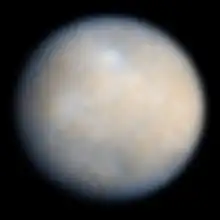
A dwarf planet is a celestial body orbiting the Sun that is massive enough to be spherical as a result of its own gravity but has not cleared its neighbouring region of planetesimals and is not a satellite. They are smaller than planets, but more massive than small solar system bodies. The term was adopted in 2006 by the International Astronomical Union (IAU) as a result of the increase in discoveries of trans-Neptunian objects that rivaled Pluto in size, and finally precipitated by the discovery of an even more massive object, Eris. The IAU currently recognizes five dwarf planets—Ceres (pictured), Pluto, Haumea, Makemake, and Eris. It is suspected that at least another 40 known objects in the Solar System are dwarf planets, but the number might be as high as 2,000. The 2006 definition has been both praised and criticized, and has been disputed by some scientists. (Full article...)